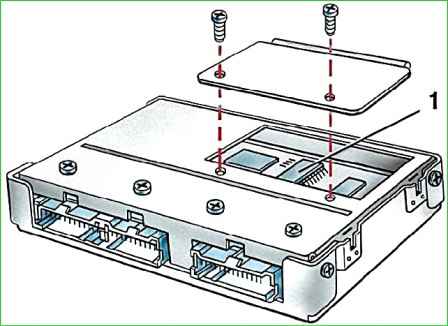The controller (electronic control unit), located under the instrument panel on the right side, is the control center of the fuel injection system
It continuously processes information from various sensors and controls systems that affect the toxicity of exhaust gases and the performance of the car.
The controller receives the following information:
- – about the position and speed of the crankshaft;
- – about the mass air flow by the engine;
- – about the coolant temperature;
- – about the throttle position;
- – about the oxygen content in the exhaust gases;
- – about the presence of detonation in the engine;
- – about the voltage in the vehicle's on-board network;
- – about the speed vehicle;
- – about the position of the camshaft (in a system with sequential distributed fuel injection);
- – about a request to turn on the air conditioner (if it is installed on the vehicle).
Based on the information received, the controller controls the following systems and devices:
- – fuel supply (injectors and electric fuel pump);
- – ignition system;
- – idle speed control;
- – adsorber of the gasoline vapor recovery system;
- – fans of the engine cooling system;
- – air conditioning compressor clutch (if it is on the vehicle);
- – diagnostic system.
The controller turns on the output circuits (injectors, various relays, etc.) by shorting them to ground through the output transistors controller.
The only exception is the fuel pump relay circuit. Only to the winding of this relay does the controller supply +12 V.
The controller has a built-in diagnostic system. It can detect system malfunctions and alert the driver via the CHECK ENGINE indicator light.
It also stores diagnostic codes that indicate areas of malfunction to help technicians perform repairs.
The controller has three types of memory: random access memory (RAM), one-time programmable read-only memory (PROM), and electrically programmable memory (EPROM).
The random access memory is the controller's "scratchpad."
The controller's microprocessor uses it to temporarily store measured parameters, for calculations, and for intermediate information.
The microprocessor can write data to it or read it as needed.
The RAM chip is mounted on the controller's printed circuit board. This memory is volatile and requires an uninterruptible power supply to save it.
When the power supply is interrupted, the diagnostic trouble codes and calculation data contained in the RAM are erased.
Programmable read-only memory (EPROM)
The EPROM contains a general program that contains a sequence of operating commands (control algorithms) and various calibration information.
This information is the control data for injection, ignition, idle speed, etc., which depend on the weight of the car, the type and power of the engine, the gear ratios of the transmission and other factors.
EPROM is also called a calibration memory device.

The contents of the EPROM cannot be changed after programming.
This memory does not require power to save the information recorded in it, which is not erased when the power is turned off, i.e. this memory is non-volatile.
The EPROM is installed in the socket on the board 1 of the controller (Fig. 1) and can be removed from the controller and replaced.
The EPROM is individual for each vehicle configuration, although the same unified controller can be used on different vehicle models.
Therefore, when replacing the EPROM, it is important to set the correct model number and vehicle configuration.
And when replacing a defective controller, it is necessary to leave the previous EPROM (if it is in good condition)
The electrically programmable memory device is used for temporary storage of password codes for the vehicle's anti-theft system (immobilizer).
The password codes received by the controller from the immobilizer control unit (if the vehicle has one) are compared with the codes stored in the EPROM, and the start is either permitted or prohibited engine.
This memory is non-volatile and can be stored without power being supplied to the controller.





